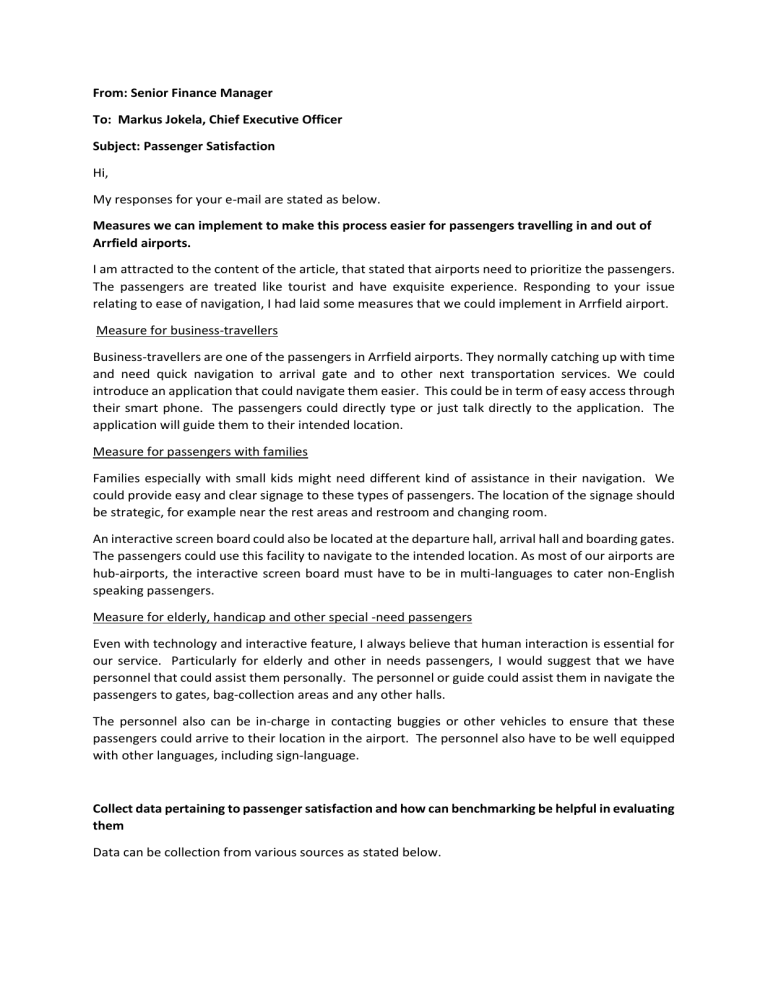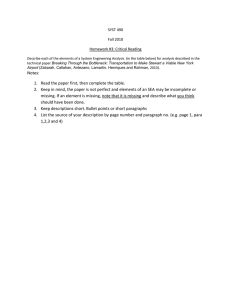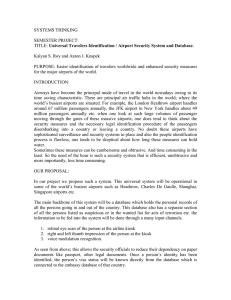
From: Senior Finance Manager To: Markus Jokela, Chief Executive Officer Subject: Passenger Satisfaction Hi, My responses for your e-mail are stated as below. Measures we can implement to make this process easier for passengers travelling in and out of Arrfield airports. I am attracted to the content of the article, that stated that airports need to prioritize the passengers. The passengers are treated like tourist and have exquisite experience. Responding to your issue relating to ease of navigation, I had laid some measures that we could implement in Arrfield airport. Measure for business-travellers Business-travellers are one of the passengers in Arrfield airports. They normally catching up with time and need quick navigation to arrival gate and to other next transportation services. We could introduce an application that could navigate them easier. This could be in term of easy access through their smart phone. The passengers could directly type or just talk directly to the application. The application will guide them to their intended location. Measure for passengers with families Families especially with small kids might need different kind of assistance in their navigation. We could provide easy and clear signage to these types of passengers. The location of the signage should be strategic, for example near the rest areas and restroom and changing room. An interactive screen board could also be located at the departure hall, arrival hall and boarding gates. The passengers could use this facility to navigate to the intended location. As most of our airports are hub-airports, the interactive screen board must have to be in multi-languages to cater non-English speaking passengers. Measure for elderly, handicap and other special -need passengers Even with technology and interactive feature, I always believe that human interaction is essential for our service. Particularly for elderly and other in needs passengers, I would suggest that we have personnel that could assist them personally. The personnel or guide could assist them in navigate the passengers to gates, bag-collection areas and any other halls. The personnel also can be in-charge in contacting buggies or other vehicles to ensure that these passengers could arrive to their location in the airport. The personnel also have to be well equipped with other languages, including sign-language. Collect data pertaining to passenger satisfaction and how can benchmarking be helpful in evaluating them Data can be collection from various sources as stated below. Passengers’ questionnaire survey A questionnaire can be distributed to the passengers relating to their satisfaction at our airports. The questionnaire needs to be developed to covers all the necessary dimensions that are in related in airport services. For example, signage and navigations, café and restaurants, frontline employees and waiting time, just to name a few. One important data that we needs are relating to the demographic of the passengers. The questionnaire can be distributed online or through hardcopy-print. All the data obtained need to be analysed and reported. Beside that, we could also distribute the data to our employees to capture their view on passengers’ satisfaction. Interview Beside that, we can do an interview to obtain the insight from the passengers, employees and airlines. With pre-determine questions and interview protocol, Arrfield could interview the passengers on their experience at the airports, their satisfactions and perhaps any suggestion to improve their experiences. Input from our employees and airlines would also enhance the quality of the data. Beside individually interview the respondents, we could also can do a focus group discussion. We could invite Arrfield frequent passengers to a focus group session. This session might be more valuable as we can have more thorough discussion the passengers’ satisfaction. Real-time feedback A instant data can be obtained from from a real-time feedback at our airports. We could place a device at the airports’ restrooms, counters or any suitable location. Passengers just could touch the screen of the device to convey their feedback, whether they are happy or not. Benchmarking can be used to evaluate the data that we had collected. Benchmarking is an activity that we can compare the data that were gathered with a certain benchmark. The benchmark is based on set of guidance, score or index. Benchmarking within Arrfield airports The first benchmark is within Arfield group of airports. This is for our internal assessment that could assist us in mapping our operation, management and strategic plans. We can benchmark and evaluate the obtained data based on the size of the airports, passengers’ traffic, type of airport (hub or nonhub) and location od the airports.As our focus is on passengers, the demographic of the passengers are also one of the important dimension in the bechmarking. Arrfield needs to set measurement as a benchmark. Let say, for a hub-airport, the satisfaction index must be at the minimum of 80%. Thus, based on this benchmark, we could determine which airports that could meet the it. Thus, Arrfield could make necessary plan to achieve the benchmark. Using benchmark, we could also make a trend analysis. Arrfield could look on the performance of passengers’ satisfaction for couple years. This is important in assessing whether or not the plan that we have on is effective. Benchmarking with airport industry To meet our vision tobe the world’s best airport, benchmarking with other airports is very important. There is available in the market a service that focus on passengers’ satisfactions. This independent consultant services could provide information on passengers’ satisfaction of other airports in the industry. The service would surely incur costs for Arrfield. However, benchmarking with other airports in the world would surely benefit us towards achieving the vision. We could also benchmark the data that we collected with our competitor, Skylaine. We could look in the Skylaine’s annual report, whether the company report on passengers’s satisfaction. Alternatively, we could obtained the data for benchmarking purposes during the focus group discussion session. From the benchmarking activity, Arrfield could strategized its plan to meet its vision and mission. Benchmarking with other service industry As an airport management company, we could also benchmark our passengers’ satisfaction data with other transportation service companies. For example, railway terminal management or bus terminal management companies. I believe that there are certain indicators that would be useful for benchmarking purposes. For example, issues relating to signage, wifi-connection and rest-areas. Hope my response could assist you. Thank you. From: Senior Finance Manager To: Anna Obalowu Sote, Chief Operating Officer Subject: Airline Negotiations Good day Madam, My responses to your e-mail are as below. How will we record airlines adopting our sustainability suggestions in our integrated reporting? Integrated reporting (IR) is a reporting framework that focus on the value creation process over short, medium and long terms. It is based on business model, where the input consists of six capitals. Our sustainability suggestions can be reported in the following capitals. Social and relationship capital The social and relationship capital relates to how the company interacts with the stakeholders and communities. Arrfield could record airlines adopting our suggestion under this capital. We could explain how we interact and have the engagement with our customers i.e. airline on how the sustainability initiatives at Arrfield. In addition, we could explain on how we built the relationship with relevant stakeholders relating to this issue. Natural capital Natural capital relates environmental resources, such as biodiversity, water and land. Arrfield could record our sustainability initiatives and suggestion under this capital. The initiatives such as Arrfield’s attempt to reduce noise pollution, carbon footprint and emission can be reported under this capital. Human capital We could also utilise the human capital reporting under the IR to record our sustainability initiatives and suggestion. Human capital relates to our people’s competencies and skills. We could report that our employees have the awareness relating to sustainability. There are adequate training and awareness program provide to our people. What else can Arrfield do to be more environmentally friendly as an airport Engagement with community Arrfield could engage with community and the residents near the Arrfield’s airport. Programs can be done that involves the community, as a stakeholder, and our company. For example, we could organise a green-based program such as re-planting activity program, beach-cleaning activity program and using public transport program. Specific campaign with Arrfield retailers, restaurants and café in the airport Arrfield could introduce specific programs with our retailers, restaurants and cafes that operated in our airports. One campaign that might be interesting would be 3R, which are Re-use, Reduce and Recycle. Similar campaigned has also been done in Hong Kong International Airport. The campaign would attract the commitment of our retailers into our sustainability initiatives. For example, we could suggest that the retailers would reduce the use of plastics packaging and move towards more eco-friendly packaging. We also could support the restaurants and cafes to re-cycle the cooking oils that they used in their operation. Establish Centre of Excellence I always believe that sustainability is a long-term effort of an organisation. Arrfield needs to invest on the sustainability program. Our company could provide research grants for universities in Norland, Farland, Eastland or any countries to conduct research on sustainability. By supporting research activities, the sustainability efforts would be more meaningful as we are supporting ways for new avenue and solution for sustainability issues. Arrfield could provide grants and establish Centre of Excellence relating to reduction of carbon emission, air pollution, water-treatment and energy saving. Principal risks of to reduce dealings with less profitable airlines at CCI airport (CCI) There are risks that Arrfield need to determine relating to suggestion to reduce dealings with the less profitable airline at CCI airport. Reputational risk The first risk is reputational risk. This risk relates to the negative image of the company. If we reduce dealing with less profitable airlines, we would be seeming as a company that does not care about passengers that require these airlines. Beside that, Arrfield would be perceived as a company that only focus on profit, without considering Arrfield’s social responsibility aspects on the passengers and employees of these airline. Business risk Other risks related to business risk. We only focus on the less-profitable airlines that operate in CCI. However, this strategy might affect our overall business. These airlines might not only operate in CCI, but also operate in our other airports. Should we reduce dealing with these airlines at CCI, our business relationship can be badly affected at other airports. These airlines might not be happy to deal with Arrfield in future. In addition, should we reduce dealing with less profitable airlines at CCI, the airlines would transfer its operation to other airport, such as airports manage by Skylaine. This will affects our revenue streams, as airlines and passengers would shift to our competitor. Legal risk We need to look on our business contracts with the airlines. Implementing this strategy without referring to the terms might affect us legally. Arrfield could be exposed to the law suits if we terminate the contracts with less profitable airlines. Market risk As a listed company, we also expose to the market risk, as our share price might be dropped after the announcement and implementation of the strategy. The investors and shareholders might not accept positively on this strategy, and will dispose their shares in the market. The investors and shareholders could either uncertain on the prospect of the strategy or due to bad reputation of the company. Hope my response could assist you. Thank you. From: Senior Finance Manager To: Romuald Marek, Chief Finance Officer Subject: Foreign Exchange Risk Hi CFO, My response are as follows. The main difficulties for Arrfield in establishing a forward contract in mitigating this risk Over the past few months we have noticed that there is a very high volatility between the USD and the currencies we use (from the 3 countries) relating to our fuel purchased Forwars contracts are indeed one of hedging arrangement that we can consider. However, there are difficulties which are below. Binding contract Forward contract is an arrangement between Arrfield and another party, which normally a bank. The contract is a binding contract, which mean that we have to agree on the term that we have set. Therefore, the due date of the contract, the amount of currency that we have entered into are fixed and not flexible. This one of difficulty that we may face if we entered a forward contract. We would have to oblige to the contract. There is no flexibility in the arrangement compared to other external hedging instruments. Rate relatively high As we deal directly with a bank, the rate of the contract is also high compare to other instruments. There are no other parties that will involve in these contracts. This would be slight disadvantage for our company as we have to incur higher cost. This would be attractive for us to enter into the contract. Not tradeable Forward contract is also not tradeable. We could only exercise the contract at the determine date. This would be difficulties should we need to protect the downside of the currency risk at another period. The movement of USD with our N$, F$ and E$ might not be what like we expected at the predetermine date. 2 other different hedging techniques that we may be able to use to reduce the risk of incurring exchange losses due to this volatility, and compare their suitability with that of a forward contract There are two other different hedging techniques, which are 1) Foreign currency future contracts and 2) Foreign currency options. Foreign currency Futures contracts Future contract are contracts that are standardize in the date, amount and price. It is tradeable contracts. As it is a tradeable contract, it is regulated market. Hence, there would be no counterparty risk. It suitable for our hedging exercise. Compare to forward contract, future contract is more flexible in term of the contract. Arrfield would not be binding to date of the agreement, as future contract is tradeable. Thus, it is more flexible. The rate is relatively lower that the forward contract. This is due to that in future contract we will entering the exchange rate. In forward contract, we need a bank to arrange the forward contract. Due to different arrangement, the rate is higher in forward contract. Standard date and amount so flexible. The limitation of future contract is the contract size. We might not get a exact match of our currency exposure with the future contract. In forward contract, we can cover the exact amount that we would like to enter hedge on. Foreign currency Options Another instrument that we can consider is option. Option is a right, not an obligation to exercise the instrument. This mean that we protect our expose on adverse effect of the volatility of the currency. As it is not an obligation, we don’t have to exercise the option should are having loss on the currency exposure. Compare to forward contract, it is more attractive in term of the term. In forward contract, we have to perform the agreement at the due date. This is due to that forward contract is a binding contract. However, in option, we have no obligation to exercise the option should the movement of the currency benefit us. However, option is more expensive that forward contract. We have to pay a premium even we do not exercise the option. This would be disadvantage and could affect Arrfield cashflow. How to set a right dividend policy given these factors 3 points Arrfield dividend policy Arrfield have been paying a large dividend and stable dividend for the last two years. We can see that in 2020, the payout ratio is 60%, and increase from 2019, which is 55%. Our dividend policy is also higher that our competitor, Skyliane. The decision to approve for dividends have to be tabled in the Annual General Meeting (AGM). KPJ Inc. could use this avenue to and might vote against any proposed dividends as what it expected. Therefore, I am of opinion that we need to engage the substantial shareholders in setting our dividend policy. We also need to look on the effect of dividend decision on our share price. Shareholders’ requirement KPJ Inc., an investment fund owning 20% of our voting shares, prefer a stable dividend. This is expected as a fund manager. This what are known as clientele effect. We would like to maintain PKJ Inc. as our shareholder and would not want KPJ Inc to reduce or dispose its shares. As I mention above, shareholder engagement is important in setting dividends. As a large shareholder, we should engage and inform the KPJ about our current business environment or our future projection. This is including our cashflow position and a range of dividends that we could pay. We also have to look on our other shareholders and their dividend appetite. This important as we are concern on the effect on the dividends, including the requirement and needs of our shareholders. Announcement effect As we can see, our shares are traded between N$33 to N$36.50 for the past years. The dividend reduction announcement might impact negatively to our share price. The cut in dividends might signal our cashflow issues or inability to sustain a good dividend. We need to consider that the market does not perceive our company as a problem company. Justification or future projects needs to be announced to the market in mitigating the effect of the dividend announcement effect. Hope my response would assist you. Thank you.



